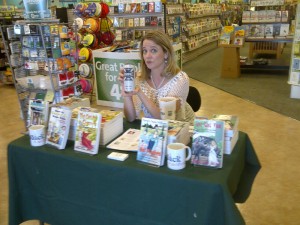
This ain’t no “build it and they will come” scenario, folks. Books signings are a hard sell, even for the traditionally published writer. Book sales are a hard sell, and, at a signing, you’re asking people to come buy your books at a specific time, in return for your smiling face and John Hancock. Your mama thinks those are special, but to most people, they aren’t much of an enticement. If you’re indie, you’ll have to work hard and smart if you want a dynamite book signing, but you can achieve fantastic results if you include these factors for success in your planning:
1. Location, location, location
Don’t go holding some random event in an area where you have no following or name recognition. Who the heck is going to come check out the Secret History of Middle American Basket Weavers unless they already know the book, and, even better, you? The only answer: no one. You won’t even get a polite drop-by from the janitor unless you went to high school with him. Why? Because people are afraid that even talking to you will result in them having to buy shit they don’t want. Right? That’s why you scurry past the vendor-person when you see them, too. You know you do. So pick a location where people know of you or your book. Where you can draw a crowd of people that came specifically to see you and buy what you are selling. Otherwise, you’re going to sit by yourself for two hours playing tiddlywinks and pretending you aren’t devastated.
And, on the subject of location, some stores charge you for the signing. It’s up to you, but you probably won’t recoup the cost, especially if you’re footing the bill for grub and giveaways (see #3 and #4). I don’t pay for book signings. I do, however, partner with the store to promote them. So I don’t talk about ebooks when I’m in the world of brick and mortar. I do suggest to customers who buy my books that they take some time in the store, and consider purchasing some of the fine merchandise available above and beyond mine. Because, to me, it’s all about making the store owner feel the event was worthwhile. If they made money, I probably did, too, and they may invite me back or become a reference for me. More on that, below.
Don’t sit around waiting for stores to invite you, either. Seek them out, introduce yourself, ask them to carry your books (the words “on consingment” work wonders, since the stores have to pay up front for all the inventory they carry from the traditional publishers — they may get part of their upfront investment back when they pulp the remaining books, but consignment is a magical, wonderful word to them), and request a signing.
2. Timing is everything
You want shiny, happy people who don’t feel rushed. You don’t want them fighting traffic to get to you. They need time to chit chat with you while you sign the book they buy, and then browse the store and buy other products your host has to offer. So pick a day and time that allows them to attend, and to shop at a leisurely pace.
3. And who doesn’t love free food?
Bring food, if the store will let you. Be sure that if you offer an alcoholic beverage that you provide a non-alcoholic choice as well, and snacks. I’m serving wine and Fre (alcohol free wine, awesome stuff), fruit, and cheese at a book-signing later this month. People are rsvp’ing “yes,” by golly, and I’m holding it at “happy hour” time.
4. Hell, who doesn’t love free “anything?”
Giveaway your bookmarks or other small items to every person who stops to talk to you. I also give coffee mugs to people who buy five books or more. I have magnets and pens for folks that buy from 2-4. Ask the store if they are running any specials in conjunction with your signing that you can promote for them; this may even provide them with a “hint.” And, finally, consider making your signing a “Q&A” or a “Workshop” instead of a signing. Sure, you can still sign and sell books, but the store and you need traffic, so give people something of value, for free, to get them to come in the store.
5. Secure commitments
Don’t take it for granted that your best friend Martha will come and bring her roommate and her roommate’s boyfriend. Promote your event. Facebook Events is a good way to start getting the word out. I then use Evite.com to send cute invitations to my contacts via email. I post my Evite on Facebook. I send it to my invitees again through Facebook inbox. (By now, they’re ready to kill me, but they’ve found they can’t ignore me) I can also use Evite to send reminders to those who RSVP’d yes, and I can tickle those that failed to respond.
I don’t stop there. I also ask the store if there is anything they can do to promote it, like posters in their lobby (which I print and mail to them, or email if I trust them to do a decent job of the printing themselves), or by the cash registers. I ask if they have recommendations for promoting it in the community, like community bulletin boards, or community Facebook pages. If the business has a Facebook page, I link to it in my Facebook Event. I invite the business. I ask them to post the Event on their wall. Finally, I send personal emails or I pick up the phone and talk to the people I want to “anchor” the event. I need 10 commitments of attendance to make the event worthwhile. See #1, Location. I won’t have a signing in a community where I don’t think I can attract 10 people. Why would I waste my time? What have a I gained?
None of these things cost money, but they all require elbow grease.
Recently, I held a book signing in a Central Texas town of about 20,000 people. I live in Houston, a community that bulges at the seams, with millions of residents. I will have signings lined up in Houston, sure, but I started with a smaller town. Why? Because I had family there.

Now, you might think the first people to buy your books when you release them will be family, and you’re right about your mom. And that’s about it. The rest may remember to buy them later if they see them somewhere, if they opened your email announcement about your book release in the first place. So I held the signing in conjunction with a family event in this town, and then my family orchestrated visits every 15 minutes in groups. I sold 50 books in two hours. I sold books to people I didn’t know, which was cool; one of them even asked to buy my upcoming novel now, which makes him my hero. My 50 book sale set a record for the store for the highest sales by an author at a book signing in their history. With only 50. Does that tell you something, people? Unless you’re Kim Kardashian, you just don’t sell in volume at signings. Heck, I was elated with 50. It blew my expectations out of the water, and the store manager said he would have considered 10 a very successful signing. But what else did I get out of it? Why was it soooo worth my time?
- I sold books. Have you noticed yet that it is hard to sell books? It is. And each book is more than a book, it is also like a business card. I may have primarily sold them to family, but those were 50 books that they wouldn’t have purchased/read otherwise, that may cause them to buy more as gifts, tell others about them, or pass them along to others who might read them, buy more, talk about them, and pass them on. Grassroots.
- I ingratiated myself with the store. They sold a lot more than my books to my customers. They did a thousand dollars in business related to my signing. The manager was bouncing up and down on his toes when he showed me my numbers and their numbers.
- As a result of my “popularity,” the store moved all my books to an endcap, with a “signed copies available” display. That placement alone sells books, makes me look IM-PO-TANT. Before, they had stuffed me in a corner under “Humor.” You could only find them if you asked at the front counter. (Ah ha, just being stocked in a store is not enough. You need placement….)
- The store gave me a reference to their corporate office and other locations. I have booked a signing in another community in which I have significant ties as a result of this success. And I plan to work just as hard to draw a crowd for the store, there.
- I had material for this blog post 🙂 and for my social media promotion. I need material that is tied to my books, because I don’t tell people to buy my books on Facebook or Twitter. I tell them when I am on a radio show, or when I have a signing, or when an article appears about me in the local paper. So, even if my signing was a flop, I have something to promote that links to my books, and none of my online community has to know I ate all the fruit and cheese myself, right? But even better if it was a success on its own merits.
I have one last tip for you. It’s about volume. I have seven published books. I brought multiple copies of five of them with me to the signing I told you about, above. Many of my customers bought three or more titles. I would never have sold 50 if I wasn’t a multi-title author. It’s worth thinking about. If you hold off until you get that 2nd or 3rd book out, you will have a lot more vroom vroom in your sales engine at a signing. Or any time someone finds you, whether online or in a physical store.
I don’t believe the days of bookstores are over. I don’t believe print books are “out” either. I do know that ebooks outsell all other individual types of books, and I hope to sell tons of ebooks, over time. Right now, I sell more books in print than I do in ebook format, but then I am only one month into my indie journey. Check back with me in a year, as “everyone” keeps telling me that ebook sales don’t mushroom (if they ever do at all) until six months after a book release. Meanwhile, I have five book signings lined up, to create name recognition and show my most accessible audience that I am “for real” as a writer, so that they might gift me with something far more valuable than their $12.95 per book: word of mouth. And even your mother isn’t going to do that for you effectively unless she’s actually read and loves your work.
Bottom line: success starts with realistic expectations and goal setting. You can do successful book signings as an indie author, but not without careful planning and a great deal of effort — the right effort. Don’t overbook yourself with poorly timed or executed signings. Pick the right location within the right community, get firm commitments from “anchor” attendees, and give more than you get, in terms of your expertise, your snacks (!), and your promotion.
Best of luck to you!






